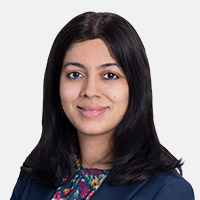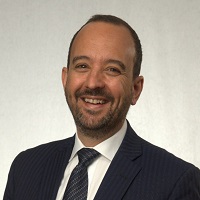By Jayson Forrest

Anu Ganti CFA (S&P DJI), David Wanis CFA (Longwave Capital Partners), and Veronica Klaus (Lonsec) discuss the role of active management in a volatile and challenging environment.
A majority of active managers fail most of the time to outperform the market, with any outperformance tending to be temporary. This was the view of Anu Ganti, CFA — Senior Director, Index Investment Strategy at S&P Dow Jones Indices (DJI) — who uses S&P DJI research to argue that index investors have an above-average chance of achieving above-average investment results.
So, why is active management so difficult?
As part of a wide-ranging discussion on active management at an IMAP Independent Thought Roundtable (in association with S&P DJI), Anu believes there are four core reasons as to why active management is difficult:
1. Varying rewards to the skill in picking stocks;
2. Return skewness;
3. Professionalisation; and
4. Cost.
According to Anu, stock dispersion can provide a tailwind for skilled stock pickers, but she also believes it’s a double-edged sword. While there is greater opportunity for stock pickers when they get the call right, there is also greater opportunity for embarrassment when they get the call wrong.
In terms of return skewness, Anu says outperformance is generally driven by a few stocks, which contributes to the difficulty of active management. “Skewness of stocks really makes the case for diversification and owning more stocks, because there’s no knowing what those few winners are going to be tomorrow. The probability of outperformance rises when portfolios hold more stocks.”
Anu believes return skewness does handicap active managers, with 50 per cent of selections outperforming the median return, and less than 50 per cent outperforming the average return. “If a majority of active managers underperform by ‘a little’, then a minority of active managers can outperform by ‘a lot’,” says Anu. “So, skewness is very important.”
And what about professionalisation?
Anu says it’s important to understand there is no natural source of alpha. In order for an investor to be above average, then somebody has to be below average. She says the total outperformance of the winners must equal the total underperformance of the losers (before costs). And the source of the winners’ positive alpha is the losers’ negative alpha. This makes active management challenging.
“With more professional investors chasing alpha and the next big stock, investing is getting harder,” she says. “And when funds shift from active to passive, it’s the least skilful active managers that lose the most assets.”
To demonstrate the point, Anu refers to the growth in passive investing, with S&P recording approximately US$7 trillion in indexed assets tracking the S&P 500 at the end of 2021.
Finally, cost is also a factor that contributes to the difficulty of active management. Anu uses the U.S. as an example, where on average in 2022, active funds were on 0.66bps, compared to index funds on 0.05bps.
In terms of costs, over a 26-year period, S&P research found that index investors achieved US$403 billion in cumulative savings compared to active funds. Whilst this figure does not include S&P’s competitors, if it did, the actual savings would be even larger.

Anu Ganti CFA - S&P DJI

Veronica Klaus — Lonsec

David Wanis CFA - Longwave Capital Partners
If a majority of active managers underperform by ‘a little’, then a minority of active managers can outperform by ‘a lot’. So, skewness is very important
When looking at investment style, like value versus growth, it’s very important to understand what’s going on under the hood. You need to disentangle style bias versus skill… That’s where active management comes in
Challenging but not impossible
Veronica Klaus — Head of Investment Consulting at Lonsec — also agrees that active management is difficult. However, while she believes it’s challenging for portfolio constructors to pick active managers that can consistently outperform the market during periods of volatility and uncertainty, it’s not impossible.
According to Veronica, manager selection should be as much about diversification of style, as it is with the actual manager itself.
“If you look at the current environment, there is not a lot of direction coming from the market —one minute, value is outperforming and the next, growth is outperforming — which means it’s important you have exposure to both styles,” says Veronica. “Manager selection should be about the totality of your portfolio, by ensuring you have various strategies within the portfolio that complement each other. Only through diversification are you able to consistently generate alpha in different environments.”
As an example, she cites the inability of a value manager to outperform the index when there is strong growth occurring in the market.
“When Lonsec is talking to a fund manager, we know we’re talking to a manager that outperforms in certain conditions. So, if we see that the market is unsettled, with wide dispersion and no real clarity, we know there are managers that excel in that type of environment. They’re the managers we’re going to be looking for. That’s what portfolio construction is all about.”
Anu agrees that the current environment provides portfolio constructors with the ability to rotate between investment styles to take advantage of market dispersion and the opportunities this creates for both managers and investors.
“When looking at investment style, like value versus growth, it’s very important to understand what’s going on under the hood. You need to disentangle style bias versus skill. For example, if you’re making a tilt and go outside the benchmark, are you doing so when the dispersion is greater, so you can get more bang for your buck?,” asks Anu. “That’s where active management comes in.”
When Lonsec is talking to a fund manager, we know we’re talking to a manager that outperforms in certain conditions. So, if we see that the market is unsettled, with wide dispersion and no real clarity, we know there are managers that excel in that type of environment. They’re the managers we’re going to be looking for. That’s what portfolio construction is all about
Value-add fund managers
However, given the high number of tertiary educated CFA graduates and finance specialists now coming into the industry, along with the rise of artificial intelligence applications like ChatGPT, does this mean the actual number of truly original value-add active managers sitting outside the status quo is declining within the market?
“It’s an interesting question,” says Anu. “They’re definitely out there, but it’s tough finding them.”
Veronica agrees. She adds that sitting at the heart of any good value-add manager is having an effective team in place that can successfully implement the manager’s processes and strategy over an extended period of time.
“There are many managers in the market with talented and skilful processes, but it’s the way in which they implement their processes, as well as the consistency and discipline in which they apply their philosophy and process, that matters,” she says. “We’ve seen some very good managers fall apart because they’ve drifted away from their core investment discipline. That’s why good quality research and a strong investment framework underpins all of our portfolios at Lonsec.”
As the Founder, Chief Investment Officer and Portfolio Manager at Longwave Capital Partners, David Wanis CFA admits to having undertaken extensive research in the lead up to establishing Longwave Capital. By doing so, he says it has enabled his team to put together an offering that provides consistent outperformance, and which looks quite different from other managers in the market.
Longwave Capital is a boutique investment manager dedicated to delivering long-term results. According to David, its investment process combines intensive fundamental analysis with cutting-edge quantitative technology, which offers investors a unique, diversified small companies fund that focuses on high quality companies that it thinks will be tomorrow’s winners.
“When setting up Longwave Capital, what was surprising for us was the response from some parts of the market. People claimed what we were doing was all wrong, because we were different from everybody else. They said we were systematic and fundamental, and holding too many stocks,” says David.
“Yes, we were doing all these things that were different, but they were actually the drivers of alpha.”
However, despite this, he accepts that being a value-add manager, which does things differently, does also come with risks.
“Being different doesn’t necessarily mean being better, but we try to make it mean better. But still, there are many other managers that don’t want to be different at all,” he says.
When setting up Longwave Capital, what was surprising for us was the response from some parts of the market. People claimed what we were doing was all wrong, because we were different from everybody else. They said we were systematic and fundamental, and holding too many stocks. Yes, we were doing all these things that were different, but they were actually the drivers of alpha
Active manager churn
While active managers can struggle with consistency of outperformance, Veronica hasn’t seen a great deal of churn in terms of asset allocators switching between active managers.
“I won’t say there’s been huge turnover,” she says. “There has been some movement but it’s not an active versus passive issue.
“At Lonsec, we’ve always had really strong research, both with active managers, as well as passive and index managers. That has enabled us to be flexible enough to identify risks and move in or out of active or passive, depending on certain market environments. These calls tend to be based on structural changes or significant events we’re seeing in the market.
“Sometimes, we use passive exposures to get a short-term exposure in our managed accounts, because it’s about gaining beta exposure rather than longer term alpha generation. I think that’s the type of turnover we’re seeing with active managers.”
However, she accepts that the approach to active management can be mixed with certain types of clients.
“Some clients have very strict budgets around costs and fees. So, for those clients, you need to take a passive approach for your beta exposure, and use your active exposure as satellites,” says Veronica.
“Remember, there’s no perfect way of building a portfolio. It’s about ensuring that your end result aligns to your investment philosophy and the investment needs of your clients.”
About
Anu Ganti CFA is Senior Director, Index Investment Strategy at S&P Dow Jones Indices;
David Wanis CFA is Founder, Chief Investment Officer and Portfolio Manager at Longwave Capital Partners; and
Veronica Klaus is Head of Investment Consulting at Lonsec.
They spoke on the role of active management at an IMAP Independent Thought Roundtable (in association with S&P DJI).

